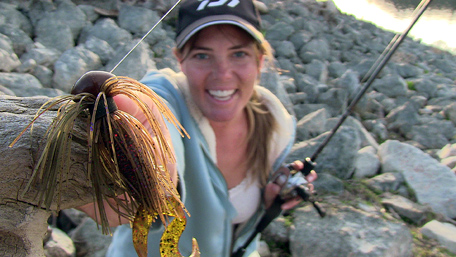
Pay close attention to the rate of fall in the wintertime.
Fishing in the winter can be tough! More often than not it seems the fish are less active than the other seasons, and on top of that, battling the cold weather while fishing can be a bother! The rate at which your bait falls can be an important factor anytime, but in cold weather when the fish slow down, I find that more often than not it is a critical component to successful fishing.
Typically the bass tend to slow down a bit in the winter, go deeper and can be found on the main lake points and deeper off-shore structure. That’s why I like to focus on finesse fishing techniques and slow down the retrieve. A typical winter fishing day starts out rigging up my Daiwa rods with a small finesse worm on a drop shot, a nail rigged Senko, a jig, and a shakey head.
It is not uncommon to hear of two anglers fishing the same technique (using the same worm) and one angler is consistently catching bigger fish. Why is that? Well it could be a number of reasons such as coincidence, or a cast to a specific hot spot, or even a slight variance in worm color. However; many times it is true that there are differences in the things that affect the rate of fall such as line sizes, weights, worm length, bulkiness of the bait, or other.
Throughout the day I might notice that the fish seem to be aggressively biting my jig but not quite taking it. Sometimes I’ll try changing the size of bait. If the fish are still teasing the jig but not taking it, then I might switch it up to a lighter or even a heavier jig head. These are subtle changes that can make all the difference!
Many of you know that I love fishing a drop shot in tournaments. When I start to pre fish a lake, it is not uncommon for me to have two to three Daiwa rods rigged up with a drop shot. Here’s why: let’s say the fish are also aggressively biting my 5” worm, but not quite taking it in. There are fish teeth marks on the worm all around the hook, but for some reason the fish don’t seem to be getting hooked well. Generally I will go down a sinker size first and see if that works. If that still does not work, I might try a different scent. If I am using a shad scent, I will try crawdad or garlic scent. If that doesn’t work, I will slow down the cadence, sometimes they like no moment at all (dead sticking it). If that still doesn’t work and a slightly different variation in color doesn’t help either, then I might change to a different manufacturer in the same size worm. Just by switching manufacturers can affect the rate of fall, not only because of size difference of the bait but because the buoyancy can be completely different also. For example a slim Senko vs. a Zoom trick worm, a Robo worm, or a Maverick worm. They are all different and as you know sometimes the fish get finicky.
When fishing a drop shot, another thing to consider is the rate of fall after the weight has reached the bottom. I have spent many hours watching different baits at my friend John Zillig’s pool. We analyze how the rigs react once they touch water, the rate of fall, their action as they fall, and their movements sitting still and with current. We also observe their action as we create certain motion with our rods and sometimes with only our reels. It has been very eye-opening watching the baits and how they react. This has been great insight and a benefit if applied on the water in the right circumstances.
When you experiment with the rate of fall keep in mind the action of a lure. Sometimes a faster fall will give a better action, but sometimes with certain lures a fast fall with kill the action. There are times, when nothing else works, and when you can use a heavy weight or a heavy jig and have a very fast decent and you will get a reaction bite.
In addition to the action, the line size can play a part in the rate of fall. A jig tied to 15 lb fluorocarbon line will sink slower than the same jig tied to 8 lb test fluorocarbon.
Take into account winter fishing patterns, fish your strengths, slow down your retrieve, and experiment with the factors that affect the rate of fall. Many times we may not notice a subtle different with the human eye, but these subtle difference can make a big differences to the bass. If you pay close attention to the details that affect the rate of fall, you will become a better angler.


 Advertising
Advertising